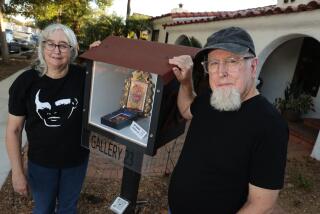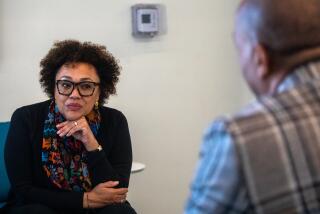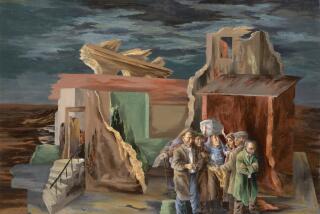NEA Finds S.D. Protest in Bounds : Funding: But arts group warns that using grants to buy bus-bench ads condemning police shootings would not be appropriate in the future.
- Share via
Four San Diego artists who used money from the National Endowment for the Arts to buy commercial advertising space to protest shootings by police have been vindicated by the agency after a lengthy investigation.
In a letter released Wednesday, the NEA said artists Elizabeth Sisco, Deborah Small, Louis Hock and Scott Kessler were “in conformance” with agency guidelines that existed in 1989, when the grant to San Diego’s Installations Gallery was made.
But the embattled federal arts agency issued a reprimand in the last paragraph of its three-paragraph announcement, which the artists claim was a concession to political pressure:
“What has concerned the Arts Endowment, however, is the use of federal funds to purchase commercial advertising space for purposes that relate to a local issue about which there are a variety of opinions. When a specific advocacy issue is involved, alternative funding or donated advertising space would be the appropriate funding source. As the endowment develops new guidelines, this distinction will be made.”
Artist Sisco said of the reprimand, “Obviously, the NEA is no longer defending the Constitution. Nor is it defending individual artists’ rights to freedom of expression. It’s just blowing with the political winds.”
According to documents obtained by The Times, the NEA allocated $4,000 to the artists in 1989 for “media advertising,” of which $3,662.50 was used to buy space on 25 bus-bench ads that appeared throughout the city between late October and early December of last year.
The overall grant totaled about $12,000 and involved other art work as well.
The controversial art depicted in the ads featured the outline of seven human bodies silhouetted in black against a red background. Within each human figure was a target, similar to those at police shooting ranges.
Within one target was a trowel, within another a baseball bat and within a third a garden stake. A pair of upraised hands and a question mark were drawn within others.
Among those killed in shootings by local police in 1990 were men wielding a baseball bat, a garden stake and a trowel. Another man was unarmed.
The NEA agreed to investigate the artists in early November, after a request from Rep. Bill Lowery (R-San Diego), who said it was “highly unusual and improper for artists to take NEA money and buy commercial advertising, regardless of its content.”
Sisco charged that Lowery was using the issue to enhance his bid for reelection against Democrat Dan Kripke, whom he defeated by 12,000 votes last November. The NEA has been under attack for some time, primarily from Sen. Jesse Helms (R-N.C.), whose criticisms led to new procedures for the agency.
Asked whether the artists had jeopardized their chances for future NEA funding, Sisco said, “It’s not a matter of fear. It’s a serious question of whether one would want to apply for funds that come with so many strings attached, or if one wants to associate with an agency that now espouses a party line.”
More to Read
The biggest entertainment stories
Get our big stories about Hollywood, film, television, music, arts, culture and more right in your inbox as soon as they publish.
You may occasionally receive promotional content from the Los Angeles Times.










